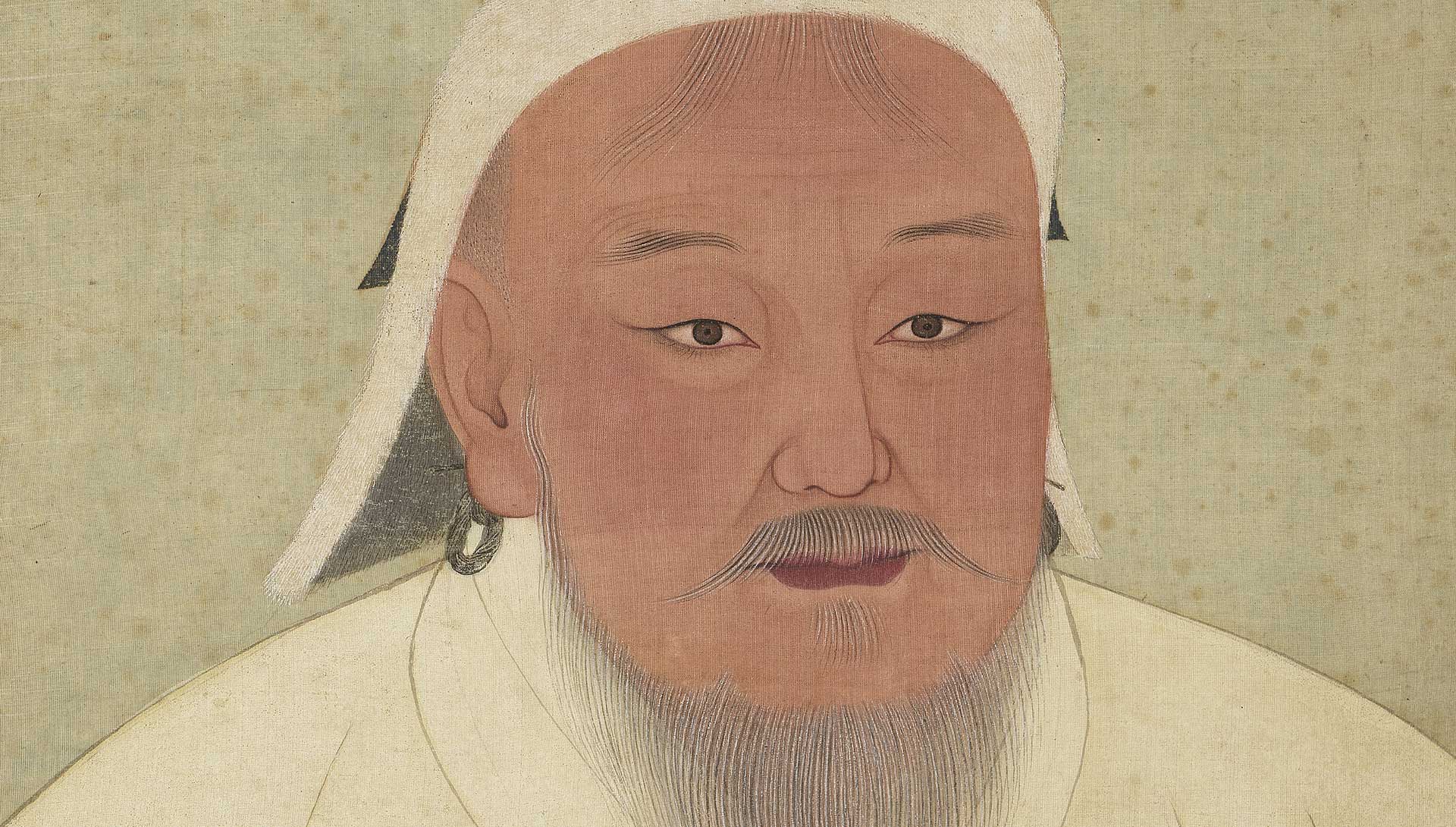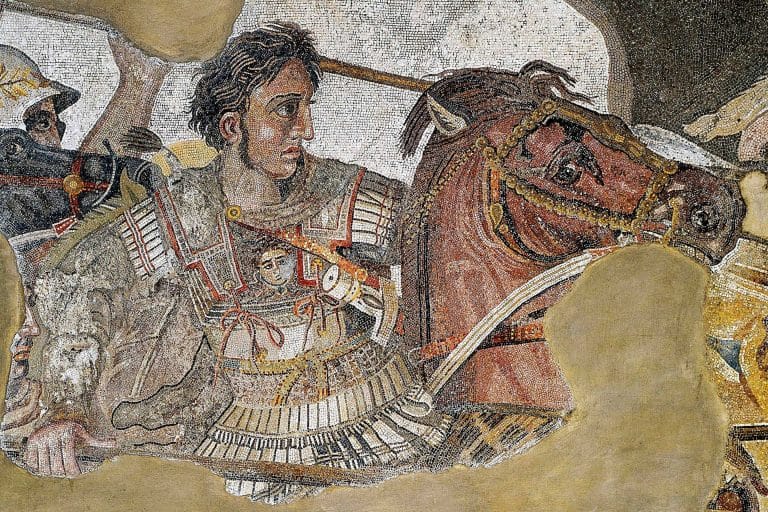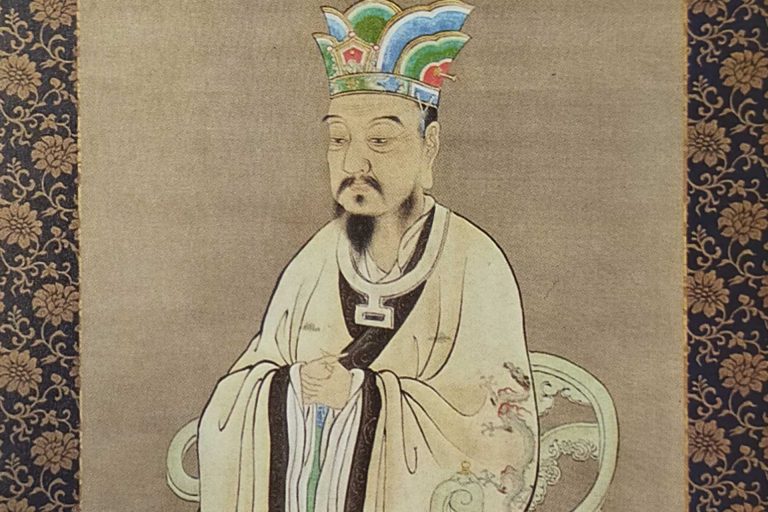Blood, Battle, & Conquest: How Genghis Khan Forged the Mongol Empire
The Mongol Empire stands as one of history’s most awe-inspiring and far-reaching conquests, a colossal expanse of land united under the banner of Genghis Khan. This article delves into the remarkable journey of how Genghis Khan, a nomadic warrior born on the vast steppes of Central Asia, rose from humble beginnings to craft an empire that would stretch across continents and shape the course of civilizations. We hope to unravel the intricacies of Genghis Khan’s life, exploring his early struggles, strategic brilliance, and indomitable spirit that propelled him to become a legendary figure synonymous with empire-building.
The Rise of a Legend
Genghis Khan, born as Temüjin around 1162 on the vast Mongolian steppes, began his life in a world of turmoil and uncertainty. His early years were marked by the harsh realities of nomadic life, where survival was a daily struggle against the elements and rival tribes. The young Temüjin was exposed to the challenges of leadership from an early age as he witnessed his father, Yesügei, a prominent tribal chieftain, navigating the intricate web of alliances and conflicts among the Mongol clans. However, tragedy struck when Temüjin’s father was poisoned, leaving his family vulnerable to the shifting allegiances of the clans.
With his father’s death, Temüjin’s family was cast out from their tribe, forcing them into a life of destitution and powerlessness. His mother, Hoelun, along with Temüjin and his siblings, faced the harsh realities of survival in the unforgiving steppe landscape. These early experiences of hardship and vulnerability would deeply influence Temüjin’s character and shape his future ambitions.
Temüjin’s upbringing was marked by a determination to regain his family’s honor and secure his own place within the world of the Mongol tribes. His early exposure to the intricacies of tribal politics and warfare cultivated his keen sense of diplomacy and strategic thinking. These qualities, coupled with the indomitable spirit he developed through the trials of his early life, set the stage for his remarkable journey from an exiled youth to the formidable leader who would later become known as Genghis Khan.

Rise to Power: From Temüjin to Genghis Khan
Genghis Khan’s rise to power was a testament to his exceptional leadership, strategic genius, and unrelenting determination. Following years of adversity and exile, he began his ascent by uniting the fragmented Mongol tribes under a common purpose. Recognizing the need for strength in unity, he sought alliances with influential leaders, forming a network of support that would prove crucial in his quest for supremacy. With an innate understanding of human nature, he also skillfully navigated the complex web of tribal loyalties, converting potential adversaries into loyal followers.
Genghis Khan’s military innovations further solidified his rise. He revolutionized the Mongol way of war, breaking from traditional tribal skirmishes to create a disciplined and efficient fighting force. He introduced tactics like feigned retreats, encirclements, and the integration of captured enemies into his ranks, ensuring his army’s adaptability and effectiveness. These innovations were instrumental in his swift conquests and the gradual consolidation of power.
In 1206, Genghis Khan’s ascendancy was formalized when he was proclaimed as the Khan of Khans, the supreme ruler of all Mongol tribes. This title marked the culmination of his tireless efforts to unite his people and fulfill his vision of a united Mongol nation. With charisma and determination, he solidified his rule by implementing a code of law known as the Yassa, fostering both social order and loyalty among his followers. Genghis Khan’s remarkable rise from a destitute exile to the ruler of a burgeoning empire stands as a testament to his unparalleled leadership and strategic brilliance.
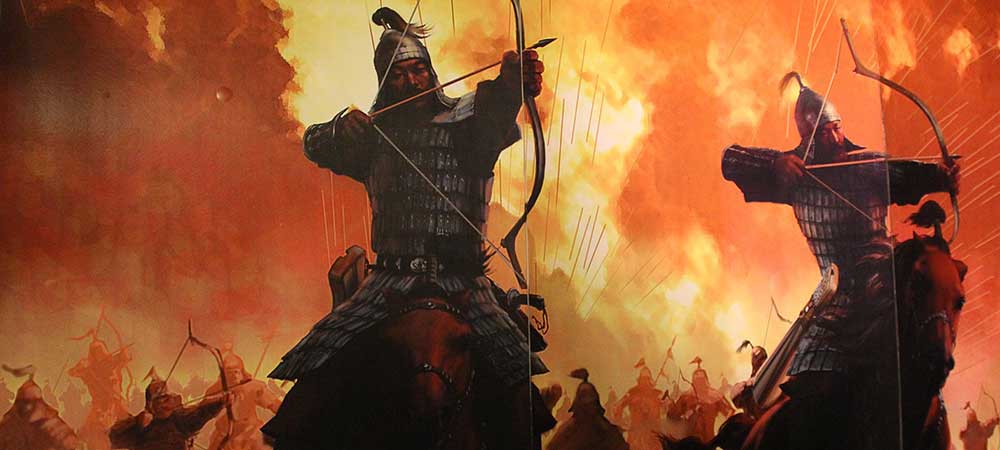
Early Battles and Conquests: The Foundation of Empire
Genghis Khan’s early battles and conquests laid the crucial groundwork for the establishment of the mighty Mongol Empire, showcasing his strategic brilliance and military prowess. After unifying the Mongol tribes, he turned his attention to expanding his dominion beyond the steppes. One of his earliest significant victories was against the Tatars, a neighboring tribe that had once captured and enslaved him. This campaign displayed Genghis Khan’s thirst for vengeance and his emerging tactical acumen, as he triumphed over his former captors and secured his reputation as a formidable leader.
However, it was the conquest of the Khwarezmian Empire that truly marked Genghis Khan’s arrival on the world stage. In response to a trade dispute and the ill treatment of his envoys, he launched a massive campaign that showcased the mobility, adaptability, and innovative tactics of his forces. The Mongols employed psychological warfare, rapid maneuvering, and siege techniques to systematically dismantle the Khwarezmian defenses and capture major cities. The fall of the Khwarezmian Empire not only enriched the Mongols with vast resources but also solidified their reputation as an unstoppable military force.
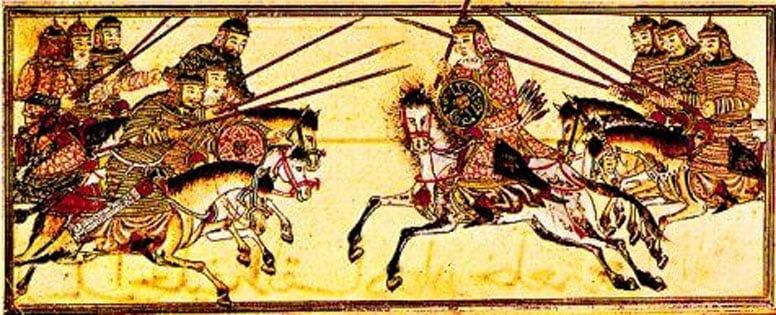
Genghis Khan’s campaigns extended beyond the Khwarezmian Empire. In his push into Northern China, the Battle of Yehuling was a pivotal engagement against the Western Xia Dynasty. The Mongols’ disciplined cavalry and skilled archery tactics overwhelmed the enemy, and this victory laid the foundation for their further conquests in the region. The campaign against the Jin Dynasty culminated in the siege of the Jin capital, Zhongdu (Beijing), a masterful example of psychological warfare and siege techniques that showcased Genghis Khan’s ability to adapt his strategies to the challenges of sedentary societies.
Despite the immense success of his conquests, Genghis Khan faced internal and external challenges to not only his rule but the Mongol Empire. Dissent within his ranks prompted his ruthless suppression of insurrections, often through public executions to maintain control. He also dealt with the powerful Khwarazm Shah, who mobilized his own forces to resist the Mongol advance. Battles such as the Battle of Parwan and the Battle of Indus River demonstrated Genghis Khan’s strategic thinking and adaptability to different terrains, as well as his ability to manage multiple fronts.
The early battles and conquests under Genghis Khan were characterized by a combination of brilliant strategy, military innovation, and a willingness to employ both fear and diplomacy to secure his dominance. His campaigns against diverse adversaries showcased his ability to adapt his tactics to the challenges posed by different opponents and environments. These triumphs provided the foundation upon which Genghis Khan would continue to expand his Mongol Empire, ultimately shaping the course of history and leaving a lasting legacy that would endure for generations.
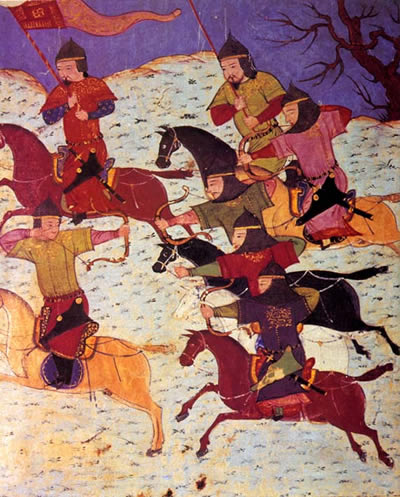
The Mongolian Lifestyle: Nomads Built for conquest
The nomadic lifestyle of the Mongols played a pivotal role in their ability to conquer new lands and establish one of the largest empires in history. Adapted to the harsh and vast steppes of Central Asia, the Mongols had honed a way of life that provided them with distinct advantages on the battlefield and beyond. Mobility was at the core of their lifestyle, as they relied on herding livestock and migrating in search of fresh pastures. This mobility not only conditioned them to endure harsh conditions but also cultivated a deep familiarity with the terrain that became a crucial asset during conquests.
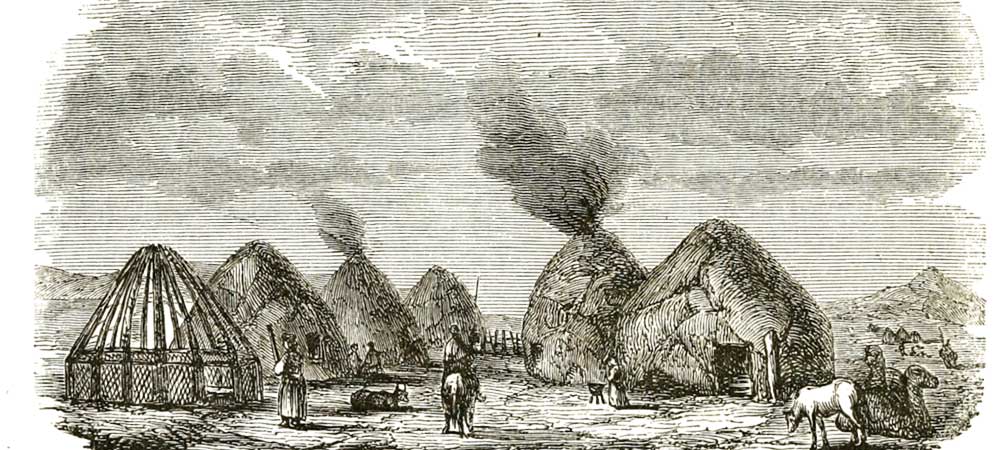
The Mongols’ expertise in horsemanship and archery set them apart in warfare. From a young age, Mongol warriors were trained to ride and shoot, developing remarkable accuracy and agility. This allowed them to launch devastating hit-and-run attacks, wear down larger armies, and swiftly traverse vast distances. Their cavalry tactics were perfectly suited for the open steppe and proved formidable even in terrains unfamiliar to them. These mounted soldiers would become the backbone and the might of the Mongol Empire.
The ability to sustain their armies through herds of horses and livestock was another key factor in their success. While sedentary societies relied on agriculture, the Mongols’ nomadic lifestyle granted them independence from fixed resources. This flexibility allowed them to remain on the move, making them harder to predict and counter by more settled opponents. They could launch campaigns with speed and surprise, catching their enemies off-guard and exploiting the element of shock.
Furthermore, the interconnected nature of their tribes enabled the Mongols to muster massive armies from across their territories. During campaigns, their clans came together to form a cohesive force, a product of the kinship bonds that existed among the various Mongol groups. This unity provided Genghis Khan with a substantial pool of warriors, all highly skilled in horsemanship and warfare, making it easier to engage in simultaneous battles on multiple fronts.
Welcome to the Mongol Empire
The Mongols’ treatment of the people they conquered and ruled over was complex and multifaceted, shaped by a combination of pragmatic governance, cultural diversity, and the legacy of Genghis Khan’s leadership. While they are often associated with brutality, their approach was not uniform and depended on various factors such as the nature of the conquered territory, local resistance, and the perceived usefulness of the local population.
Genghis Khan’s successors recognized the importance of administrative efficiency in maintaining control over their vast empire. They implemented a system known as the “Yam,” a network of relay stations and messengers that facilitated swift communication and allowed for the efficient management of the empire. This administrative structure was vital for the governance of far-flung regions, ensuring that orders were transmitted rapidly and that local issues could be addressed promptly.
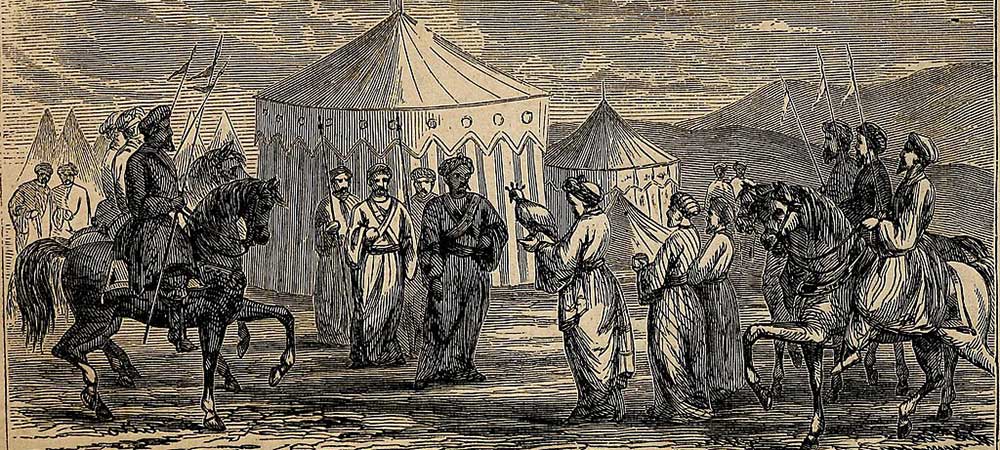
The Mongols were pragmatic rulers who often allowed local leaders and institutions to remain in power, as long as they pledged loyalty to the Khan and paid tribute. This approach allowed them to co-opt existing structures of power and reduce the chances of local uprisings. Moreover, the Mongols valued skilled individuals regardless of their origin, often integrating conquered artisans, scholars, and administrators into their empire to enhance its cultural and economic prosperity.
While the Mongols did resort to brutal tactics in instances of resistance, they also demonstrated a degree of religious tolerance and openness to cultural exchange. This was evident in their willingness to adopt administrative practices, technologies, and even religious beliefs from the conquered territories. Additionally, the Pax Mongolica – a period of relative peace and stability under Mongol rule – facilitated trade and cultural exchange across the vast empire, allowing for the exchange of ideas between East and West.
In regions where the Mongols encountered resistance or faced challenges to their rule, their response could be severe. The sack of cities like Nishapur and Baghdad demonstrated their capacity for ruthlessness. However, it’s important to note that these instances were not representative of their overall approach. The majority of conquered people experienced a level of governance that, while different from their previous systems, often allowed them to continue with their way of life as long as they acknowledged the authority of the Mongol Empire & its ruler.
In summary, the Mongols’ treatment of the people they conquered was a blend of pragmatism, administrative efficiency, and cultural diversity. While instances of brutality occurred, they were not the defining characteristic of Mongol rule. The empire’s longevity and cultural exchange during the Pax Mongolica underscore the complexity of their governance, which left a lasting impact on the territories they ruled over.
Later Campaigns and the Ever Growing Mongol Empire
Genghis Khan’s later campaigns extended his conquests across diverse regions, showcasing his military prowess and strategic innovation. One notable campaign was directed toward the Kievan Rus, a federation of East Slavic territories. Genghis Khan’s forces, led by his generals, engaged in fierce battles that resulted in the defeat of numerous Rus principalities. The Mongols utilized a combination of psychological warfare, siege tactics, and cavalry maneuvers to dismantle resistance and assert their dominance over the Rus territories.
Genghis Khan’s military ambitions also led him to the heart of Central Asia, where he set his sights on the Khwarazm Shah’s realm. This powerful empire posed a formidable challenge, but Genghis Khan’s meticulous planning and adaptability allowed him to conquer territories stretching from modern-day Iran to Uzbekistan. The strategic use of feigned retreats, utilization of defectors, and encirclement tactics showcased his ability to overcome daunting odds. The eventual fall of the Khwarazm Empire enriched the Mongols with immense wealth and further solidified their reputation as a formidable force.
In his campaign against the Eastern Xia Dynasty, Genghis Khan demonstrated his ability to adapt his strategies to the challenges posed by settled societies. The siege of Caizhou stands out as a prime example of Mongol siege tactics, as they besieged the city for nearly a year before achieving victory. Genghis Khan’s ability to meticulously plan and execute prolonged sieges underscored his determination and strategic genius
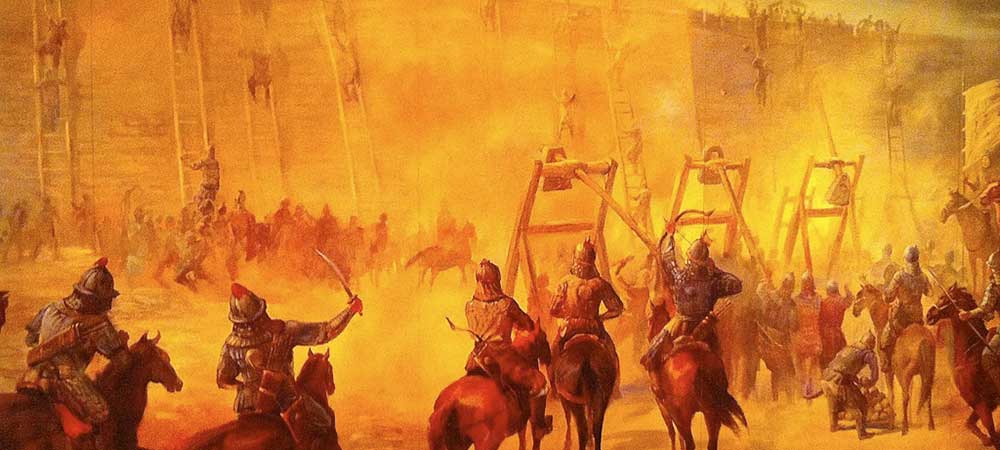
Furthermore, Genghis Khan’s ambitions extended into the Middle East, where he targeted the Khwarezmian-ruled region of Transoxiana. The Battle of Parwan highlighted his adaptability to different terrains and his skill in coordinating multiple fronts simultaneously. The Mongols employed a combination of mobility and precision to achieve victory, showcasing their military superiority over the settled societies they encountered.
Despite his vast conquests, Genghis Khan’s later campaigns did not solely focus on military victories. His expansion into Eastern Europe was accompanied by diplomatic overtures to establish trade and alliances with the Western powers. These diplomatic efforts demonstrated his multifaceted approach to empire-building, as he recognized the value of both military might and political alliances.
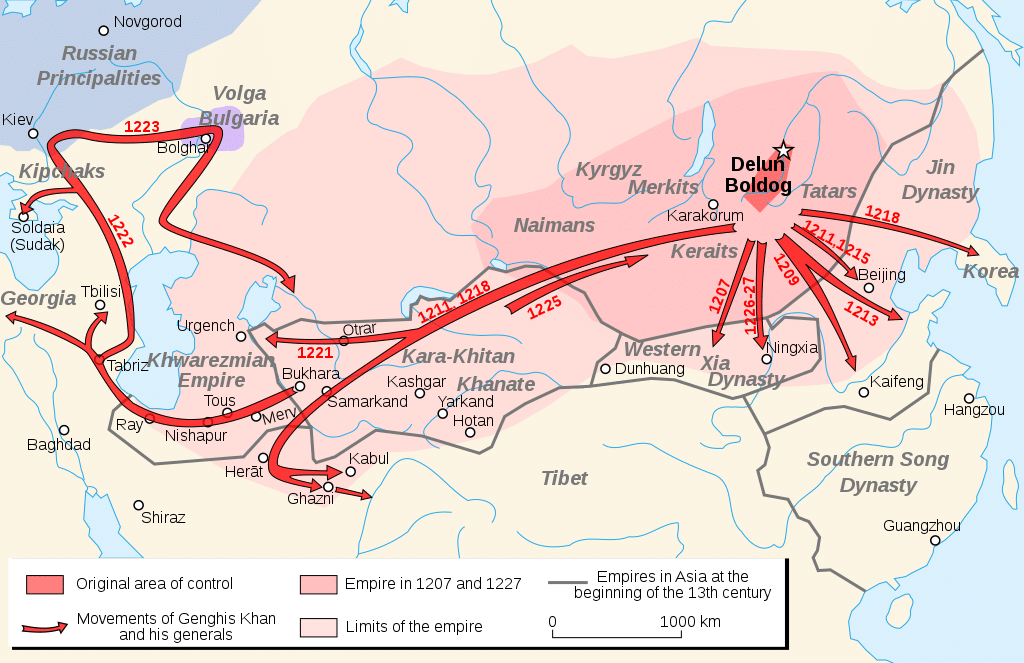
derivative work Bkkbrad / *File:Gengis Khan empire-fr.svg: historicair 17:01, 8 October 2007 (UTC), CC BY-SA 2.5 https://creativecommons.org/licenses/by-sa/2.5, via Wikimedia Commons
The End of the Man: The Continuation of the Mongol Empire
Genghis Khan’s death in 1227 marked the end of an era and set the stage for the succession of his empire to his descendants. His demise, though shrouded in some mystery, is believed to have been caused by injuries sustained during a fall from his horse during a military campaign. His passing left a power vacuum that would be filled by his capable successors, particularly his four sons: Jochi, Chagatai, Ögedei, and Tolui.
The succession of Genghis Khan’s Mongol Empire was guided by his vision of a united Mongol nation, and his choice of successor was influenced by a careful balance of military prowess, leadership abilities, and loyalty to the Khan’s legacy. Ögedei Khan emerged as the chosen successor, becoming the second Great Khan of the Mongol Empire. Ögedei had proven his capabilities both in battle and in diplomatic negotiations, and his leadership was characterized by his ability to continue expanding the empire while maintaining the administrative systems Genghis Khan had established.
Under Ögedei’s leadership, the Mongol Empire continued its relentless expansion across Asia and into Europe. His reign saw the conquest of territories like Hungary, Poland, and the Volga Bulgars, as well as the expansion of Mongol control into the Middle East. Ögedei was adept at harnessing the talents of his generals and administrators, allowing him to manage the vast empire that Genghis Khan had left behind.
In conclusion, Genghis Khan’s death and the subsequent succession of Ögedei Khan marked a critical juncture in the history of the Mongol Empire. While Genghis Khan’s visionary leadership had laid the foundation for the empire’s formation and early conquests, Ögedei’s rule ensured its continuity and further expansion. The transition from Genghis Khan to his successor demonstrated the resilience of the Mongol leadership and their ability to maintain unity and strength even after the passing of their founding leader.

